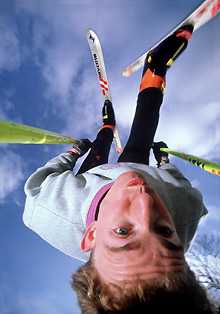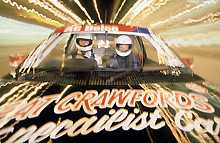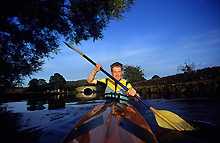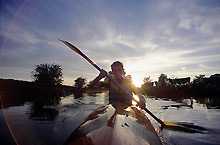
Sport fills TV channel time and newspaper space as never before in 1996, but how many saleable sports action images do most freelances have? Unless you are covering a major event, competing with the staffers and agencies, any sports you photograph locally are not going to provide saleable pictures.
My solution to creating unique and valuable pictures for sports sponsors and publishers, with good prospects for long-term repeat sales, has been to stop looking through the camera. You don't have to be there holding the camera if you can use a remote release (either a cord, a radio release or an infra-red trigger). And if you are not holding the camera, it can go in some unorthodox positions.
The pictures here are all taken, unless otherwise mentioned, using a robust manual Nikon FM fitted with a motordrive, remote release, and a Tamron 17mm lens. My other camera body is a Canon F-1 - another very tough camera - and the Tamron has an interchangeable mount, so that it can be used on both Nikon and Canon systems.

The cover picture used a home-made clamp to hold the Nikon rig on the ski pole. When the skier somersaulted, the alumininium plates clamping it on by wing nuts were enough to keep it firmly fixed and ensure it was always in the position I planned. Tests showed that the skier's face tended to be in shadow when he was upside-down, so I placed a Metz 60 CT-2 flashgun to one side and balanced it with the sky exposure.

For cricketers, I used a mini tripod, and a long cable release. Yes, the bowler and fielder are far too close, but to get a good combination of scales and perspective I had to set this up on a very short wicket... An exposure of 1/250 at f8 with Fujichrome 100 gave the right balance of action-stopping and depth of field, and the ball never once hit the camera (or me, which would have been very painful).

The rally car shot, taken for sponsors, involved some very careful driving. The Canon F-1 was mounted using a suction clamp (Cullmann market one of these) on the bonnet. The lighting was from two Metz flashguns in a car travelling just in front, and one Vivitar flash bounced off tinfoil taped to the dashboard. I sat in the passenger seat and fired the shutter by a remote cord.
We were only travelling at 20 mph, and to give a feeling of movement from the street lights, a time exposure of ten seconds at f11 was used with Fujichrome 400 film (balanced to the flash).

I also appear in the cycling shot! The camera was clamped to my bike while I took a ride down some country lanes, and fired the shots with the cable concealed from view in the hand which which was off the handlebars.


Finally, the canoe shots are also a self-portrait. Firing the remote camera was not easy, as I could not paddle with a release in my hand. I could not lean forward to change any camera settings, either. The solution was to mount the camera with the suction cup and then lash it one with rope for extra security, set it to 1/125 at f8 with Fujichrome Velvia 50 film, and operate the remote release with my foot!
For the final picture I deliberately turned round to get a backlit image with any water drops coming from the paddle catching the light.
The 17mm ultra-wide lens has worked every time, but because of the extreme angle of view and the amount of background included, trying to get the best composition has been a matter of trial and error - and shooting plenty of film.
The best single frames have then been duped up to 5 x 4, which looks much more impressive on a light-box and removes any chance of an irreplaceable original slide being lost or damaged.
-Paul Ridsdale can be contacted on 0113 2735482